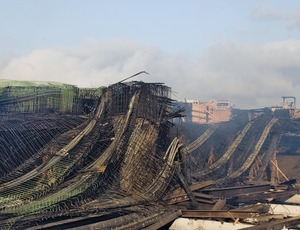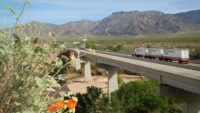
Investigators had not determined at ENR press time whether the May 5 collapse of the $59-million Interstate 15 overpass project was caused by code violations or negligence: Before the collapse, a fire was ignited on that windy day as construction workers used blowtorches to cut excess rebar from falsework.
The fire, which temporarily shut a vital artery connecting Los Angeles and Las Vegas, "was the result of contractor activity, but whether or not it was negligence is one of the issues still being investigated," said Tim Watkins, public information officer for the San Bernadino Associated Governments. SANBAG is the lead agency on the project, working in conjunction with the California Dept. of Transportation and the city of Hesperia.
The general contractor, Security Paving, which declined to comment, previously had completed several projects for Caltrans, state construction documents show. The Sylmar, Calif.-headquartered firm has an estimated 500 employees and $250 million in annual revenue.
"Fire safety is definitely a part of our training programs. Contractors do have guidelines for working in high winds and other dangerous conditions," said Hart Keeble, business manager for Reinforcing Ironworkers 416, Norwalk, Calif. "Those guidelines would be what reinforcing workers would follow. But we're still trying to figure out exactly what happened."
Security Paving and Caltrans are already co-defendants in a wrongful death lawsuit, resulting from a May 2013 construction-site accident in which a motorist was killed in a collision with a dump truck on Interstate 40 in San Bernadino. "There were no cones, signs, flagmen, pavement markings or any other warnings placed on I-40 to warn motorists," said Los Angeles insurance law firm Shernoff, Idart, Echeverria and Bentley.
The lawsuit alleges "negligence, governmental liability for negligent acts, dangerous condition and failure to warn of dangerous condition."
So far, there has been no official estimate of damage to the I-15 project, Watkins said. "The project itself did not incur any losses. Now, the contractor had some losses, and they'll work with the insurance company on that."
Not all the work completed to date on I-15 near Hesperia was damaged. "This project is not a loss," Watkins said. "The contractor was ahead of schedule at the time of the accident. Once an evaluation of the concrete work around the abutments and center columns takes place, the contractor will be able to submit a recovery schedule and set a new completion date for the project. We won't know if this project has lost any time until then."
Destroyed in the fire was the bridge's falsework that held the ironwork in place before concrete was poured, along with the rebar steel and steel beams already put in place. "All of the surface work also will have to be redone, but the ramps and the area leading up to the abutments were relatively unscathed," Watkins said. "Again, extensive investigation will [determine] if the columns can remain in place." The fire occurred about a week before the concrete was to be poured to form the overpass superstructure.
The Ranchero Road Interchange has been a much-anticipated project because it will improve access to I-15 for the citizens of Hesperia, Watkins said. "It will cut about five miles off commutes for a lot of people and ease the traffic burden on Main Street."


Post a comment to this article
Report Abusive Comment